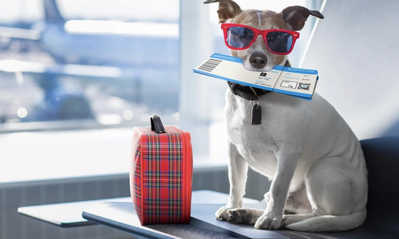Traveling with furry friends has been a growing trend over the past year. Here are 4 things you need to know before traveling with your pet.
A couple of months ago, I flew for the first time with a dog. My partner and I were bringing our foster dog, Bono, from New York to his forever home in Florida.
It was an interesting experience and one that we didn't feel prepared for – even by the time we boarded the plane. Having done it once, I was still curious about what a vet would advise pet owners do to prepare for flying with a beloved furry friend.
So whether it's your first time or you want to confirm you've been taking the proper precautions, I consulted Dr. Jeremy Kimmelstiel, an associate regional medical director at Bond Vet in New York City, on how to fly with a dog.
►Pet travel tips: What to know before taking your first pandemic trip with your dog or cat
►When the fur needs to fly: Airlines are making it tricky, costly to bring your pets
This interview has been edited and condensed for clarity.
Q: How would you advise people to prepare to fly with a pet?
Kimmelstiel: Ensure you are aware of all rules and regulations put in place by your airline, the Transportation Security Administration and your destination before venturing to the airport with your furry friend.
Chat with your vet about any concerns you may have for Fluffy or Fido well in advance of your trip. I would say 6-8 weeks before you're scheduled to depart if you can. This will allow time to update any necessary vaccinations, try out any medications prior to travel day and sort out any pre-existing health concerns. Plus, if your destination requires travel paperwork, it may need to be on a very strict timeline.
Acclimate your pet to their carrier. Leaving the carrier out in a comfortable place, such as the living room or your bedroom, will make them less anxious about getting into it to leave the house.
Q: How does one tell what an airline requires?
Kimmelstiel: I would recommend checking your airline's website or calling their customer service department to find out exactly what is required for pets to fly on their aircraft. Airlines vary greatly in what they require, and requirements can be changed frequently.
If traveling internationally, you should also check with your destination prior to departure to ensure your pet meets all health requirements for entry.
(An aside: Airlines have requirements in place for pets to fly. United, the airline we flew on, for example, requires: your pet to be of a certain age, to be traveling with an adult, to pay a fee for your pet to fly, potentially requires documentation for your pet depending on your destination and a pet carrier if the pet is flying in-cabin.)
Q: If your pet is anxious, how would you suggest helping them stay calm?
Disclosure: The day we flew, we called the vet's office and a representative suggested giving our dog half of a Benadryl before departing.
Kimmelstiel: If you have an anxious pet, you should reach out to your family veterinarian to discuss anti-anxiety medications that may be an option. Just like in people, Benadryl may make our pets a bit groggy, but it doesn't work to ease anxiety. If you have a very energetic pet that could use a bit of help to snooze on the plane, Benadryl could be a good option for them. However, again I would recommend discussing this with your family veterinarian as well to ensure that you are giving the correct dose.
Q: Are there any health risks for pets flying?
Kimmelstiel: There are certainly health risks for all pets flying in cargo, most of which are temperature-related. The cargo hold of airplanes is rarely climate controlled which means your pet may be exposed to very high and/or very low temperatures. Temperature variations are usually tolerated quite well by healthy adult dogs and cats, but there are certainly exceptions.
Brachycephalic breeds (dogs and cats with smooshed faces) such as French Bulldogs and Persian cats are more prone to overheating in extreme temperatures. Puppies, kittens and senior pets are more likely to suffer from hypo and hyperthermia as they have a lower ability to regulate their own body temperature.
Q: Any airlines that are the best for flying with pets?
Kimmelstiel: Most of the major airlines welcome furry family members with restrictions and regulations on how this can be done. Airlines like JetBlue, American Airlines and Southwest all have their rules outlined on their website. It is difficult to define which is the best as every pet and every travel circumstance is different.
Q: How much does it cost to get the health certificates you need to fly?
Kimmelstiel: Health certificates can vary in cost depending on the number of forms required and destination.
International health certificates will typically cost more as there are heftier requirements and longer forms to be completed. A domestic travel certificate is usually a single form required by the airline to ensure the pet is healthy enough for air travel.
At Bond Vet, health certificates can range from just under $200 to approximately $600 depending on the variables mentioned above. It is also important to keep in mind that these costs do not include any additional items that may be required by the country of destination, such as rabies titers or deworming.


